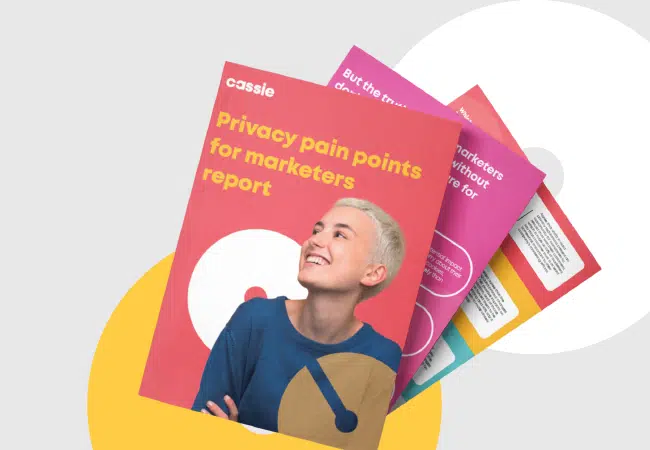The reality of cookie consent fatigue
Posted: July 25, 2023
Cookie banners are supposed to serve an important purpose for end users: to protect and enforce their data privacy preferences.
They’re also a mandatory compliance requirement around the world. But more often than not, the cookie consent ux feels like a nuisance.
We’ve all been on websites that push the boundaries of what data regulations require for collecting consent. Misleading tactics, pop-ups with no way to disagree, hidden preferences, shady opt-in practices…
The owners of these websites are likely failing to meet compliance standards across most jurisdictions (knowingly or unknowingly).
But not only that, they’re adding to a growing problem: cookie consent fatigue.
Users are fed up with poorly configured cookie banners interrupting their browsing experiences online.
Many blindly accept cookie permissions despite concerns over how their data is shared, with half of US consumers accepting all cookies.
The more concerning impact is that users will actively decline cookie permissions out of frustration.
According to our research, 79% of US consumers would like to see individual companies be more responsible and desire the ability to easily opt-out. Even more interestingly, 87% say this would make them more likely to opt-in to cookies.
Businesses need to bridge the gap. They need to find cookie management solutions that allow users to make an informed decision without overwhelming them with too much information. Or worse, not providing enough information.
- Why are there so many cookie banners these days?
- The causes and consequences of cookie consent fatigue
- How ITP and privacy browsers add to cookie consent fatigue
- Practical strategies and technological solutions
- How can we foster a culture of meaningful consent
- Overcome consent fatigue with a user-friendly CMP
Why are there so many cookie banners these days?
The advent of the European Union’s General Data Protection Regulation (GDPR) redefined data privacy and security in new ways. It put users in the driver’s seat to control their personal data sharing with companies. Of all the key aspects that make GDPR special, obtaining explicit and informed consent from individuals before processing their personal data is both beneficial and tiresome at the same time.
Under the GDPR, Article 6 (Lawfulness of processing), Article 7 (Conditions for consent), Article 12 (Transparent information, communication, and modalities for the exercise of the rights of the data subject), and Article 13 (Information to be provided where personal data are collected from the data subject) encompass the obligation to present privacy notices to individuals at the time their personal data is collected.
GDPR, as an omnibus data protection law, has set a precedent for the protection of data and privacy. Since its coming into force, more than 71 countries have enacted data protection laws that are similar to the GDPR . As enforcement agencies tighten their grip on companies’ methods of collecting and handling consumer data, privacy consent actively gatekeeps access to personal data. Cookie consent banners aren’t going anywhere, if anything, they’re only going to appear in more locations around the world.
The causes and consequences of cookie consent fatigue
Since the GDPR was introduced and more nations across the globe followed suit, there has been a significant uptick in consent requests. In a bid to ensure compliance, organizations are obliged to ask their customers for consent multiple times, across multiple different touchpoints.
As a result, consumers are becoming increasingly frustrated with consent barricading access to websites and dark patterns within the cookie consent notice.
In response to privacy regulations, web browsers are increasingly becoming privacy-conscious . Apple (Safari), Mozilla (Firefox), Google (Chrome), and others are shifting away from targeting individuals without their consent. The demise of third-party cookies has heralded a new era of consent-driven digital marketing characterized by authenticated customer experiences.
As in all industries, attracting new customers outweighs the expenses of retaining them. A seamless customer experience is crucial to that loyalty. If retailers continue requesting consent at each stage from returning customers, they induce user frustration and risk losing their business to competitors.
In a report by the Exchange Lab and Populus in 2022 , over 1,000 people in the United States and the United Kingdom expressed their attitude toward cookie consent. It was discovered that three-quarters (-72%) of youth respondents were exasperated about consent pop-ups preventing access to websites and web applications. 56% of older respondents aged between 25–34 and 44% aged between 35–54 experienced dissatisfaction.
Interestingly, 2% of all age groups favored not giving consent to cookies. The report implied that even though the users were reluctant to share their data, their preference for opt-in still outweighed the opt-out process.
How ITP and privacy browsers add to cookie consent fatigue
Intelligent tracking prevention (ITP), introduced by Apple (Safari), and other privacy-focused browsers such as FireFox, aims to protect users from cross-site tracking. Although with positive intentions, they, too, add to cookie consent fatigue.
With third-party cookies blocked by default or phased out, websites must re-obtain consent to collect first-party data directly. This means that repeat visitors are repeatedly asked to consent, leading to consent fatigue (thus more likely to opt out). Find out how the Cassie Identity Service can eliminate this problem.
Furthermore, businesses are designing more complex consent interfaces to comply with tightening privacy regulations.
These UIs go hand in hand with privacy browsers’ requirements to allow users to manage their data preferences conveniently. However, the design of the interface and the message nestled within may not resonate with the brand’s services, leading to overwhelming the users. Users may skim through details and agree or disagree with everything simultaneously, contributing to fatigue.
Practical strategies and technological solutions to address cookie consent fatigue
The constant barrage of consent management banners poses significant risks to website owners and web visitors alike. Businesses must implement strategies to continue collecting user data without violating data privacy regulations or user expectations of seamless experiences.
As few people understand the intricacies of data privacy, consent, or their rights in any depth, they tend to opt in with selective blindness. A few companies may exploit this negligence to appear to respect privacy rights and compliance convincingly, but this indisputably hampers B2C relationships.
Users want strong privacy regulations to ward off privacy abuses, but they hate to scroll through legal text and deal with banners and pop-ups repeatedly. Organizations should acknowledge that consumers want to know they can trust the companies they interact with. Customizing a cookie banner UI (user interface) to resemble the services of the website is as important as compliance functionality.
Treating consumer data and related consent as something precious to be requested and used sparingly is also important. Before obtaining consent or collecting any data, companies should determine what types of data they are requesting and for what purposes. Then, they should outline what types of consent they would require regarding its collection, storage, and use and how long the consent is valid.
Fortunately, technological advancements are being made in the privacy world that marketers should embrace. Understanding the “consent” businesses have from customers is critical to avoid bothering customers with repeated consent pop-ups. A consent management platform (CMP) allows businesses to collect explicit and informed consent from users following data privacy laws.
CMPs enable businesses to consolidate consent into a centralized, secure, and undisputable record. They reduce the frequency of consent requests and provide clear and concise information about data processing practices. More advanced CMPs can identify and match consent preferences across devices, creating a seamless experience for the customer.
CMPs build transparency and encourage users to feel in control and trust the platform – not get overwhelmed by consent fatigue through informed user experiences. Granular consent options empower users to tailor consent preferences to their comfort level, reducing the likelihood of blanket consent fatigue.
How can we build a culture of meaningful consent
Fostering a culture of meaningful consent requires a collaborative and coordinated effort from all stakeholders, including policymakers, marketers, the IT team, end users, and DPOs.
The following are the key steps to promote meaningful consent:
- Clear communication: Communicate consent requests in a clear, simple, and understandable manner to improve the consent experience. Avoid the use of jargon or legal language that may confuse people.
- Granular consent options: Granular consent options allow consumers to choose the data they feel comfortable sharing, weighing it against specific purposes, so provide the list of optional cookies. Avoid the binary consent option of “select all” or “reject all”.
- Transparency: Try to be as transparent about data collection practices as possible. Explain the purposes for which data is intended to be used and the third parties with whom data is shared within an easily accessible privacy policy link. Guide users into understanding the implications of giving or withholding consent.
- User-friendly interfaces: Design interfaces with users in mind so that they can easily manage their consent preferences and understand their choices. Make revoking consent as simple as giving it for a positive cookie consent experience.
- Privacy by design: Consider privacy implications from the outset and integrate the privacy by design framework and approach into the development of systems, processes, and services to ensure that data protection measures are built into the system.
- Educate users: Educate the public about the significance of consent and data privacy. As people become aware of how their data is collected, used, and shared, along with the implications of providing consent, their fatigue will reduce, leading to informed decision-making.
Overcome consent fatigue with a user-friendly CMP
Consent is not a one-off, tick-box event; it’s an ongoing process that requires strategic preparation and regular improvement. It’s a personalization and privacy paradox that people want privacy regulations to limit abuse of their personal data, but when consent comes into action, they evade it.
Organizations should understand the value of informed consent for compliance and developing one-on-one, strong relationships with customers for mutual benefit.
As important as it is to educate people on the importance of data privacy and consent thereof, it’s also vital to take advantage of consent management platforms for ease of consent collection and compliance with privacy regulations.

68% of the most-visited websites fail GDPR compliance tests
Many organizations are still not compliant with cookies. Consumers expect more from the brands they choose to spend with. Learn how to make informed decisions on your cookie policy that keep you compliant and enhance customer experience.

